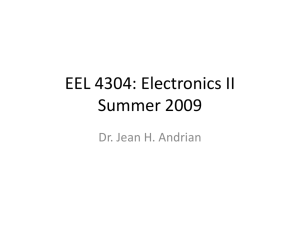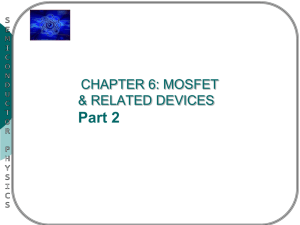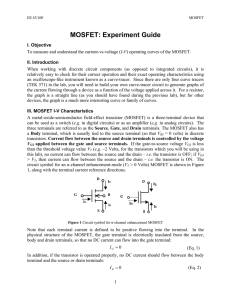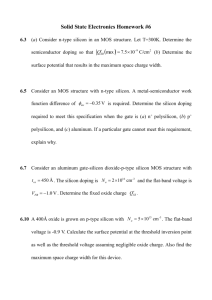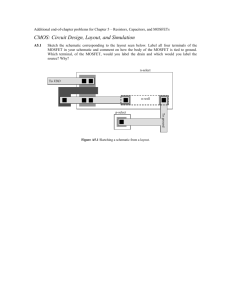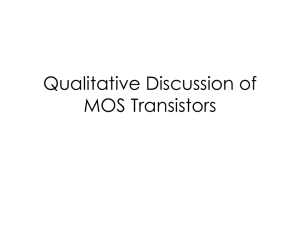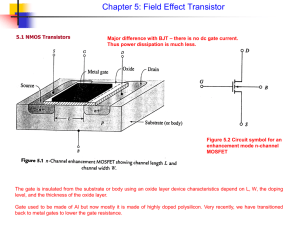HW11 Solution
advertisement
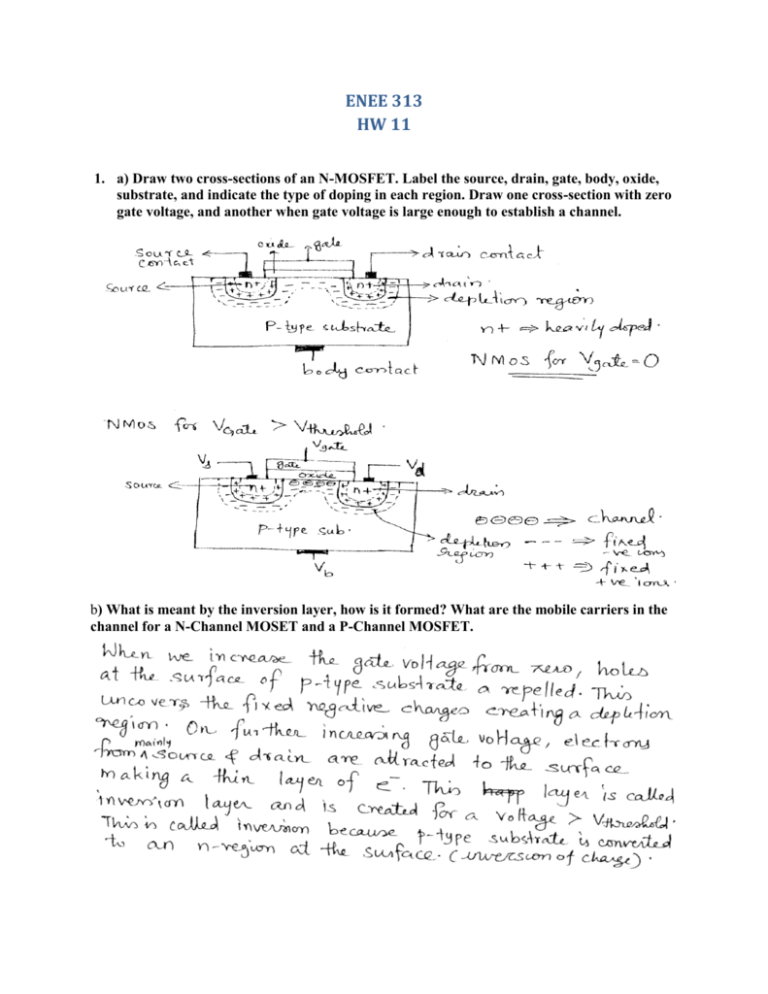
ENEE 313 HW 11 1. a) Draw two cross-sections of an N-MOSFET. Label the source, drain, gate, body, oxide, substrate, and indicate the type of doping in each region. Draw one cross-section with zero gate voltage, and another when gate voltage is large enough to establish a channel. b) What is meant by the inversion layer, how is it formed? What are the mobile carriers in the channel for a N-Channel MOSET and a P-Channel MOSFET. c) Qualitatively, explain how and why the gate voltage affects the mobile carrier concentration in the channel and the drain current. 2) Describe qualitatively how a MOSFET works. In an N-Channel MOSFET, the current that flows into the drain and out of the source is largely controlled by the voltage applied to the gate. Since the current flow between two terminals (the source and drain), is controlled by a voltage applied to a third terminal (the gate), we refer to the MOSFET as a voltage controlled current source. Channel Formation and Threshold Voltage: First of all the source and the body of the NMOS transistor are grounded. A positive voltage is then applied to the gate, and another positive voltage is applied to the drain. The positive potential applied between the gate and source (VGS) acts to forward bias the source-substrate (N-P) region near oxide at the top of the device. The electric field arising from the gate-to-source voltage points in the direction that is opposite the built-in field due to the source-substrate PN junction. This reduces the total electric field and allows electrons from the source to diffuse into the substrate region at the top of the source near the gate oxide. Now, these electrons that diffuse out of the source are also pulled up against the insulating oxide by the gate field. However, since the oxide is an insulator, the electrons from the source cannot enter the gate electrode but will gather under the oxide, resulting in a large concentration of mobile electrons in the P-substrate right under the gate oxide. This large concentration of electrons under the oxide is called the channel of mobile electrons, or just the channel. The value of the gate-source voltage (VGS) necessary to create a channel is called the Threshold Voltage or VTH. Once a channel is formed, current can flow between the source and the drain. If a voltage is now applied to the drain, with the source still grounded, then the field that results from this drainsource voltage (VDS), acts to pull the electrons that are in the channel into the drain and eventually into the drain contact wire. This electron flow out of the drain contact then manifests itself and drain current (ID), which flows into the drain. Cutoff: if there is no channel formed, there will not be a drain-to-source current in the MOSFET. To understand this considers the following. The voltage on the drain is a polarity that reverse biases the drain-substrate PN junction. Typically, virtually no current can flow in a reverse biased PN junction. So, unless there is a channel that supplies electrons to the drain, no drain current will flow if a drain voltage is applied. When there is no gate-source voltage, or if it is below a certain threshold, then there will be no channel formed, and there will be no drain-source current, even when a voltage is applied to the drain. Under these conditions the MOSFET is said to be in Cutoff. 3) Why is the DC input resistance of a MOSFET equal to infinity? Why is a MOSFET a field effect device, while a BJT is not? 4) An N-Channel MOSFET has Na=1017/cm3, Ndpoly = 1019/cm3, Tox=10nm. L=0.5um and W=20.0um. Let mobility μn = 500cm2/V-sec (Note that the electron mobility by the MOSFET surface is lower than in the bulk.) 1. Calculate the Threshold Voltage for this MOSFET 2. Sketch the family of curves for the MOSFET above for VGS=1,2 and 3 Volts, and VDS=0,1,2,3,4 and 5 Volts for each value of VGS. 3. Calculate the width of the depletion region under the gate if the surface potential is zero volts. 5) Explain the difference between the two regions of operation of a MOSFET: Linear and Saturation. Include the words pinch-off and depletion region in your answer. 6) Derive the expressions for the small signal output resistance, transconductance and input capacitance. 7) Draw the small signal equivalent circuit of an N-MOSFET in Problem 4 above when VGS = 2V and VDS = 3V. 8) Re-derive the expression for the current voltage for an n-Channel MOSFET that we did in class. Fill in any steps that we may have skipped in class. 9) Qualitatively explain the process for deriving the threshold voltage. Why do we say that inversion is reached when the surface potential is equal to negative of the substrate potential?

